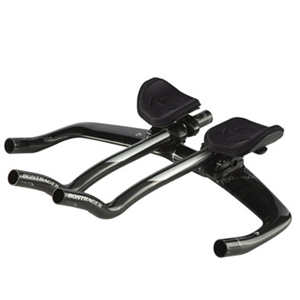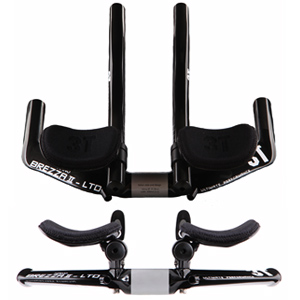Zipp Vuka Alumina Clip
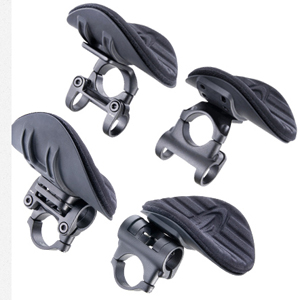
If you look closely, you'll notice a new motif showing up in aerobar design. The armrest and extension are linked. Fixed. They move up and down as a unit, with the spatial relationship between pad and extension unchanging. That complex moves up and down together.
This is the preferred way for an aerobar pad to adjust up or down, because if you simply pedestal the pad, and your forearm sits planar on the pad, then your hand expects to find an extension waiting for it and—lo!—the extension is somewhere down there below the hand. The extension needs to elevate as the pad elevates.
I believe I first saw this on the precursor to the Giant Trinity Carbon, or perhaps it was an early Specialized Shiv. I don't remember. But when I saw this it seemed like a new design standard poised to push existing designs aside.
Bringing this to market has been another matter. Aerobar makers are big ships to turn, because they're locked into manufacturing rhythms that take years to cycle.
Zipp has hit the cycle about right with its new Vuka Alumina Clip. It's not exactly first-to-market with this idea. Bontrager brilliantly aided its sister company Trek by designing a spot-on aerobar that mates with the 9-series Speed Concept. This was in 2010, and Bontrager came out a year or so later with an aftermarket version of this bar, the Race X Lite. When I host retailers for our bike fit workshops, the Bontrager is routinely selected by them as among the most comfortable, desirable aerobars in my collection.
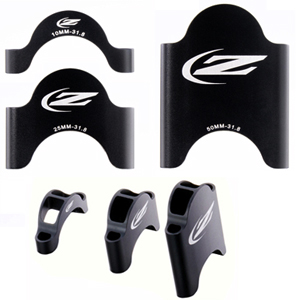
The Bontrager bar hit the target with great pad and extension shapes, and with great adjustability, primarily through the ability of the pad and extension to move up in height as a unit. The Vuka Alumina Clip does what the Bontrager bar does: the pads and extensions raise as a unit.
Let's talk for a moment about what the Bontrager does that the Vuka Alumina does not do. Then we'll move to the advantages that the Vuka Alumina has over the Bontrager.
The Bontrager is adjustable in height in smaller increments. Its aerodynamically shaped pedestals are stackable, so, you achieve the height you want in erector set fashion. The Vuka Alumina Clip's pedestals, shown adjacent, are not stackable, so, you get 10mm, 25mm, or 50mm pedestal options.
The Bontrager's pads also feature a tilt adjustment—the pad and extension can be tilted downward or upward—and the Vuka Alumina does not. The Bontrager also features a very nice extension shape that is between the old Blackwell Wrist Relief and a standard ski bend. This is probably my favorite extension shape currently for sale.
The Vuka Alumina Clip does not have that nose-up or nose-down pad/extension adjustment feature, but this feature that the Bontrager bar exhibits is really not necessary in the aftermarket version. It's a vestigial feature that was very much needed in its original design, because—remember—the Bontrager bar was first designed to be placed aboard the Speed Concept 9-series bike, which featured a pursuit bar that was fixed at one particular "tilt", and the aerobar bolts atop this pursuit bar. There is no tilt at all in this system. So, Bontrager's engineers designed tilt into the system. That design carries over to the aftermarket bar, and it would be extra work to remove this feature from the system. But since pursuit bars rotate inside the 31.8mm stem clamp, and the aerobars rotate around the 31.8mm pursuit bar, this feature is unnecessary in any aerobar that bolts onto a standard pursuit bar.
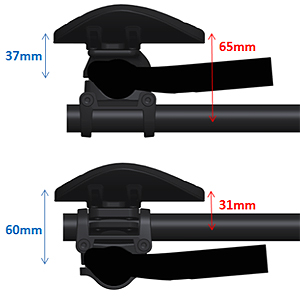
The Zipp Vuka Alumina Clip has one clever design feature that the Bontrager does not have, and it will prove very important to OEM bike makers. Both the Bontrager and the Vuka Alumina sit with the pads 6.5cm above the centerline of the pursuit bar. This makes these bars "high profile" in my opinion (that's not good or bad, it just is). The Bontrager bar adjusts upward from there, so that the pads can sit 7.5cm above the pursuit bar, 9cm, 11cm, pretty much whatever you want. But the pads cannot sit lower than 6.5cm above the pursuit bar.
The Vuka Alumina is designed so that the extensions can be placed underneath the pursuit bar if you so choose, rather than in between the pursuit bar and the pad. This means the nominally high profile Vuka Alumina changes its personality altogether, and becomes a low-profile aerobar. In this configuration, the pad sits only 3cm above the centerline of the pursuit bar.
This is a major achievement from Zipp, and should be very welcome to OEM bike makers, if those OEMs, and their retailers, recognize that this bar obviates the need to replace the stock aerobar altogether to make a new bike fit a customer.
There is only one fly in the ointment. Remember the utility of having the height between pad and extension remain a fixed distance? That's true throughout the range of upward adjustability of the pads except and until you move the extensions underneath this pursuit bar. The fixed distance of 37mm that Zipp otherwise preserves is out the window, and the new elevation between extension center and pad bottom grows to 60mm. This is not a deal breaker. It just means that instead of hacking a bunch of tube off the upturned terminus, to bring the shifter down in elevation to where your hand wants to grab, more of that elevation after the upturn needs to be preserved. Instead, hack off the extension behind the pad.
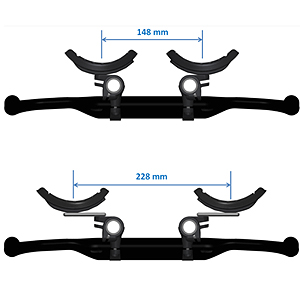
Here's my admonition, therefore, both for you end-users who want to buy this bar, and for OEMs who want to spec it: do not choose the S-bend extension unless you know for a fact that you'll need this bar in its high-profile config; and unless you know you like S-bends. This bar probably ought to be purchased with its ski bend extensions.
This bar is sold as sub-assemblies. And this is great, because, if you're a fan of (let us say) Cobb's Wrist Relief extensions, you aren't forced to buy Zipp's extensions. All these extensions made by just about all these companies are 22.2mm in diameter, so, you can buy Zipp's armrest assembly and Bontrager's extensions or Cobb's or anybody's extensions.
The pad and clamp assembly sells for $120. This does not include the pedestals. These are sold for $25, and while there are three heights, as noted above—10mm, 25mm, 50mm—you don't get all three heights when you order these. You don't get six pedestals. You get two. So, you have to know what you need before you order them.
This is going to force retailers to order up a lot of pedestals, so that all these sub-assemblies can be mixed and matched. And bravo I say. But it's going to be interesting to see what it is OEMs decide to do. Include all 3 pedestal sets with every bike sold? I think that's overkill. But OEMs are going to have to coach their retailers in this. These retailers, one way or the other, are going to have to get hold of an inventory of pedestals.
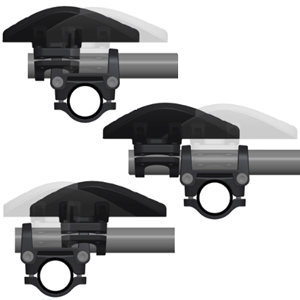
The extensions are another $55. Now, again, you can get these extensions wherever you want. If you want to save a little money, I see Easton ski bends at $30 a pair. Ritchey ski bends can be had for $28. 3T for $50. So, look at the weights of each, and the price, and the shape, and maybe Zipp works for you and maybe one of these other extensions work. Just make sure they're 22.2mm in diameter (most are) and if you choose to upgrade to carbon, make sure it's a carbon extension that has plenty of crush strength, and can handle the pressure of a pad that holds body weight cantilevered to one side, and prone to outward rotation when that weight overcomes clamp pressure.
For example, some of those carbon Wrist Reliefs cracked when Blackwell clip-on pads were bolted onto them. Was that the fault of the extension or the clamp? I don't know. Until I stick some Wrist Reliefs in these Vuka Alumina Clips and tighten them firmly, I won't know. I'll do that and report back.
So, the whole system can be had for $120 (pad and clamp) + $55 (extensions) = $175, if you don't need the pedestals. Or $150 if you choose budget extensions. If you want to keep the integrity of Zipp throughout, and you need a set of pedestals, the whole Zipp aerobar system tops out at $200.
And this is the final achievement of this bar, versus the $800 Bontrager. The Zipp is very nicely priced, whereas the Bontrager Race X Lite, while a supreme bar, and at a price commensurate with its quality, is too pricey to be placed OEM on mid-priced bikes, and is a premium bar for premium wallets.
The Vuka Alumina pad seems quite comfortable. It's big. It's long fore/aft. Which is all very good, because the more pad, the more surface area to hold up your body weight, meaning the pressure per given area of your forearm is reduced.
Zipp has designed a bar here that meets just about every design and market imperative. It's modular. It's comfortable. It's adjustable. And it's cheap. It's like somebody at Zipp sat down and wrote out a list of everything that makes an aerobar work for end users, bike shop personnel, and bike makers. Then designed a bar, in the Zipp Vuka Alumina Clip, with those imperatives in mind. What a concept!
This aerobar is not available as of this writing, but is slated to be in stores by this upcoming June.


